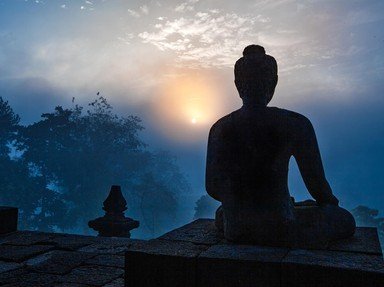Quiz Answer Key and Fun Facts
1. Adamu, also known as the jumping dance, is part of a ritual known as the Eunoto, when young warriors enter manhood. It is characterized by vertical jumping while keeping a stiff, upright posture, usually within a circle of other warriors. Which cattle culture people of Kenya and Tanzania perform this ritual?
2. The Kancet Papatai is a traditional war dance of the Dayak of Borneo, expressing the courage and skill of the legendary hero, Kenyah. The dancers wear bark armor and wield swords and shields. Due to what ferocious activity were the Dayak so feared by Europeans in their early exploration of Borneo's interior?
3. The Khattak dance is a war dance rooted in the Mughal Empire. Up to 40 dancers, each wielding one or two swords weighing 2.5 kilograms each, dance quickly, spinning to the up-tempo beat of a piper, clarion, and drums. Which alliterative pair connects the tribe and territory of Khattak dancers?
4. Undoubtedly the best known of all Polynesian dance forms is the subject of a week-long festival called the "Merrie Monarch Festival" in honor of King David Kalakaua. The festival culminates in three days of competition including both individual and group dancing. Which dance is this?
5. Ikperikpe-ogu is a war dance that originated in Bende, in what is now Abia State, Nigeria. Ancestors of the Ohafia clan were known as fierce warriors and displayed the heads of killed enemies on "oyaya head boards" while dancing the war dance. Today the dance features flexing of the pectoral muscles in rhythm to the music. Which traditionally animistic Nigerian ethnic group practiced the ikperikpe-ogu?
6. The haka is a traditional war dance of one of the South Pacific's indigenous peoples. Nowadays often seen in sporting venues such as the Rugby World Cup, which people originated this ritual dance and chant?
7. The Hamatsa is a secret society among a Canadian Pacific Coastal people known for their woodcarving, especially their masks. Prior to European conquest, this Hamatsa War Dance included ritually eating of the flesh of their enemies, resulting in a frenzy that often included the biting of fellow dancers. Which secret society is this?
8. Originally a war dance, this fast paced dance probably originated with sailors in the Greek and Byzantine navies, incorporating fast and tricky footwork that might be required on the pitching deck of an ancient warship. Perhaps the most characteristic dance of Crete, which is this that shares part of its name with an edifice of the U.S. Department of Defense?
9. Similar to other traditional dances of Greece and the rest of the Balkan Peninsula is this Romanian folk dance performed by men and women holding hands or with interlocking arms, and dancing in a circle. Its steps and name are also very similar to traditional circle-type dances in Israel. What is its Romanian name?
10. The Bumba-meu-boi dance is part of a festival that celebrates the legend of an outcast cowboy and the magical resurrection of a bull. The biggest festival takes place in the city of Parintins, tracing its 18th-Century origins to the state of Maranhao. In which region, which includes the world's largest rain forest, are these locations, as well as that of Manaus, which also keeps the legend and festival alive?
Source: Author
shvdotr
This quiz was reviewed by FunTrivia editor
stedman before going online.
Any errors found in FunTrivia content are routinely corrected through our feedback system.

